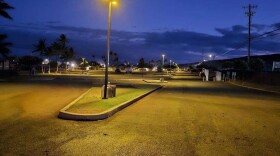Coqui frog populations have exploded since their accidental introduction to Hawaiʻi in the late 1980s. In some places on Hawaiʻi Island, it's hard to remember what the night sounded like without a chorus of croaking frogs.
A volunteer effort, in partnership with several state agencies, is trying to make sure the same thing doesn't happen on Oʻahu.
Since October, volunteers have been meeting every Thursday evening in Waimānalo to hike around in the dark and capture frogs.
Coquis have gained a foothold in Waimānalo and Kuliʻouʻou in recent years.

Ryan Chang said that at night, he can hear the calls of frogs echoing off the steep cliffs of the nearby mountain range from half a mile away.
Chang works with the state's Division of Forestry and Wildlife to lead the coqui capture crews on Thursdays.
On a given night, the crews catch anywhere from five to over a hundred frogs, said Chang. He credits the work of volunteers and state officials with curbing the spread of coquis in the region.
Chang, who is from Waimānalo, added that the effort is critical to preserving the community’s soundscape.
A single coqui frog's croak can reach up to 90 decibels — as loud as a hairdryer or some power tools. When they call to one another, coquis drown out other sounds in Waimānalo that have cultural significance.
For instance, the wind in Waimānalo has its own name: līpuʻupuʻu, according to Chang.
"It's a wind that was named after līpuʻupuʻu limu, or seaweed," he said.
He worries that the unique sound of līpuʻupuʻu in Waimānalo will be "erased" if talkative coqui frogs take over the forest.
New volunteers are welcome to sign up to join a coqui capture crew in Waimānalo. Chang notes that the first and last Thursdays of every month are geared towards experienced volunteers, and the second and third Thursdays are designed for beginners and families. Find more information here.




